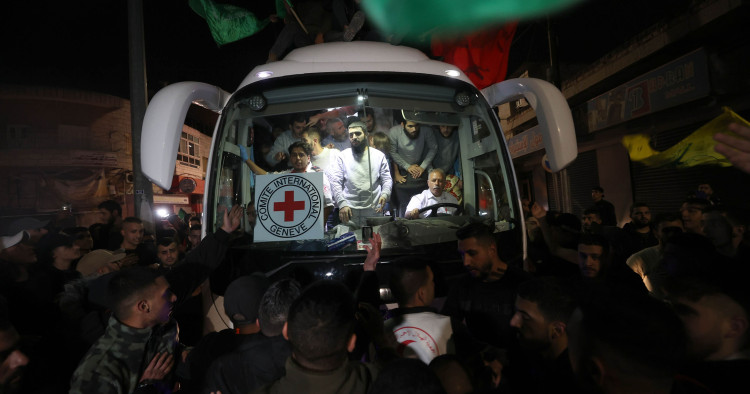Contents:
- Israel-Hamas truce extended but prospects for a longer deal remain dim
- The Biden administration achieves important but limited diplomatic results with hostage releases and a short-term cease-fire
- West Bank in turmoil amid growing violence and worsening economic conditions
- Houthi Red Sea hijackings underscore growing alignment with Iranian plans to redraw regional order
Israel-Hamas truce extended but prospects for a longer deal remain dim
Paul Scham
Non-Resident Scholar

-
It seems unlikely that the interests of the Israeli side, Hamas, and concerned outside actors can be harmonized into what almost the whole international community, outside of Israel, would like to see: a longer pause in the fighting.
-
In the short term, the possibility of an extended cease-fire beyond a few more days is low, unless and until the U.S. decides to ratchet up the pressure on the Israeli side, though this would further complicate their shared goal of eradicating Hamas.
As of the morning of Nov. 27, the hostage/prisoner release issue is at the center of discussions about the Israel-Hamas war. However, the main actors — roughly Israel on one side and Hamas on the other — along with the involved international community, have contradictory aims and embody differing circumstances. It seems unlikely that they can be harmonized into what almost the whole international community, outside of Israel, would like to see: that is, a longer pause in the fighting. Israel has announced it would resume its military operations in Gaza as soon as the current hostage prisoner exchange and an additional two-day-long pause in hostilities are over.
To the surprise of many, the temporary, six-day halt in fighting to allow the prisoner/hostage exchange as well as the delivery of badly needed food, fuel, and medicine has worked out fairly smoothly. As agreed, Hamas released 13 or 14 women and children each night on Friday, Saturday, and Sunday, and a similar number of freed hostages is also expected very shortly on Monday. Saturday night’s exchange was delayed over complaints by both sides, as was Monday night’s, but these snarls have now been ironed out and the exchange is proceeding. Israel is readying to release from prison approximately 40 Palestinian teenagers and women, presumably all from East Jerusalem and the West Bank. Scenes of jubilation on both sides have accompanied each release.
The negotiations are being brokered primarily by the Qatari government, with the active participation of the United States, Egypt, and others. Israel says for every 10 hostages let go it will pause hostilities one additional day as well as release 30 more Palestinian prisoners. Hamas reportedly wants the truce extended. The latest reports have confirmed a two-day extension. Why not longer?
First, it appears that Hamas’ claims of difficulties in locating the hostages seem to be true, at least to some degree. The hostages are presumably scattered throughout Gaza’s 300 miles of underground tunnels, and apparently a number of them are under the control of other political groups, such as Palestinian Islamic Jihad, and even by families and clans important in Gazan society. In addition, which is rarely mentioned, some hostages were undoubtedly injured or killed in the Israeli bombardments that have reportedly hit over 5,000 targets so far.
The broader obstacle to a more enduring pause in hostilities is the Israeli government’s stated objective that Hamas must be “destroyed,” a goal it has maintained since Oct. 7 and in which it has been solidly backed by a comparatively united civil society. The meaning behind this war aim was and remains unclear — and the Israeli government has been adamant it will recommence bombardment and ground operations as soon as the truce, including any short extensions, expires.
The international community, however, is increasingly insistent on a long-term cease-fire, with the notable exception of the United States, the only country with significant, though perhaps not decisive, influence on Israel. The U.S. does support an extended humanitarian pause (the word “cease-fire” has become too toxic for it to use) but also backs Israel’s primary aim of eradicating Hamas, parallel goals that seem contradictory.
Israel insists that the bombardment itself is a primary reason for Hamas agreeing to the hostage release, though others feel that the twin aims of destroying Hamas and obtaining the release of all the hostages inherently work at cross purposes. Domestic Israeli pressure to prioritize the release of the hostages has been growing, which has assumed a partially political character. Most Israelis on the far right, including some in the government, feel Hamas’ eradication must be goal number one; as such, they have opposed the current pause in fighting and certainly will strongly resist any significant extension. Yet these decisions will ultimately be made by the “war cabinet,” which includes former Israel Defense Forces (IDF) Chief of Staff Benny Gantz, the leader of the country’s most prominent opposition party.
The current tone of optimism among the international community about an extended cease-fire, well beyond the agreed-upon two additional days, is likely misplaced. The shock and horror felt by Israelis, including many Israeli Palestinians, regarding the atrocities of Oct. 7, are too fresh — and are intensified by the continual mass viewing of videos of the atrocities. The number of women and child hostages is obviously decreasing. But as far as the male hostages, numbering between 100 and 150, there seems to be no current discussion. Hamas considers them all soldiers — many indeed are — and recalls the 2011 release of the captured Israeli soldier Gilad Shalit in return for 1,000 Palestinian prisoners. Many in the international community, and some in Israel, have called for an “all for all” exchange that would include the estimated 7,000-8,000 Palestinians Israel holds, many convicted of serious offenses, in return for all hostages, currently numbering around 200. This government is highly unlikely to consider that, but new elections are probable next year, which will undoubtedly change the government’s personnel and perhaps its policies as well.
In the short term at least, the likelihood of an extended cease-fire beyond a few more days is low, unless and until the U.S. decides to ratchet up the pressure, something it may well do. Rumors are that IDF commanders are expecting perhaps two to three more weeks of combat, whether or not the goal of Hamas’ eradication is attained, which remains an unlikely proposition.
The Biden administration achieves important but limited diplomatic results with hostage releases and a short-term cease-fire
Brian Katulis
Vice President of Policy

-
The fragile nature of the cease-fire between Israel and Hamas underscores the structural challenges to brokering a lasting end to the conflict.
-
Deterring and marginalizing actors opposed to a lasting peace requires a long-term approach and deeper U.S. engagement in the region.
The past few days saw a brief respite from the war that began with the Hamas-led attack against Israel on Oct. 7. The scenes of reunions between hostages released from Gaza and Palestinian prisoners released from Israeli jails and their families, combined with a fragile cease-fire in the conflict and increased deliveries of humanitarian aid into Gaza, have become the lead story for the moment. Meanwhile, diplomats are looking for ways to extend the ceasefire further, following Qatar’s announcement of a two-day extension on Nov. 27.
President Joe Biden and his team expressed some hope this weekend that this pause in the fighting might create a window for a more lasting end to the conflict. But the chances for success seem quite slim, in large part because the goals expressed by the combatants are incompatible and there is no shared vision of what a sustainable end state should look like.
The mood across the Middle East is deeply pessimistic about the situation in Gaza and the sense that actors like Iran and its network of proxies are upending a fragile regional order and seizing the narrative. Perceptions about the United States are remarkably negative, with many assigning blame to Washington for the war, even though Hamas initiated it.
The United States remains engaged in an overdrive crisis management mode in the Middle East, with its posture more reactive than proactive. This mode is not sustainable and strains the bandwidth of the Biden administration, as it continues to address China, the Ukraine war, and climate change, among other pressing challenges.
In order to bridge the gap between short-term crisis management and long-term policy planning, the Biden administration should engage its partners across the Middle East in an effort to define a clearer and more realistic end state to the current war and the broader Arab-Israeli conflict. This will require two things.
First, the United States will have to commit more diplomatic and military resources to the Middle East than the Biden administration did in its first two and a half years in office, when it mostly operated cautiously while prioritizing other national security issues. Deploying additional resources to the Middle East cuts against the grain of arguments made for more than a decade in the United States over the past three administrations.
Second, if the Biden administration wants to see significant progress toward its stated goals, including achieving a two-state solution, the U.S. will need to find ways to deter and marginalize the forces that oppose such a vision. This includes Iran and its network of proxies, which continue to threaten the U.S. and many of its partners in the region. It also means finding a way to marginalize the voices inside of Israeli and Palestinian politics who oppose a two-state solution, which is no small task.
The Oct. 7 attack was a wakeup call about threats that continue to plague the broader Middle East. The brutal war it sparked, with all of the costs it has entailed, is a reminder that visions for a more integrated, prosperous region require a significant investment of time and energy to achieve.
Follow on Twitter: @Katulis
West Bank in turmoil amid growing violence and worsening economic conditions
Anas Iqtait
Non-Resident Scholar

-
Already witnessing its deadliest year since the Second Intifada, the West Bank has seen a sharp increase in the number of Palestinian casualties from Oct. 7 to date, including over 220 killed and more than 1,200 displaced.
-
The already precarious security situation is further destabilized by worsening economic conditions caused by Palestinian laborers with jobs inside Israel having their work permits revoked, a drop in international aid disbursement, and the Palestinian Authority’s struggle to pay civil servants or settle local supplier bills.
Since the Oct. 7 Hamas attack and subsequent Israeli bombardment and invasion of Gaza, the West Bank has also been plunged into turmoil. Already witnessing its deadliest year since the Second Intifada, the region has seen a sharp increase in the number of Palestinian casualties. From Oct. 7 to date, over 215 West Bank Palestinians, including 55 children, have been killed by Israeli forces. Additionally, Israeli settler militias have killed eight Palestinians, one of whom was a child. This period has also seen over 1,200 Palestinians, including 500 children, displaced from their West Bank homes due to settler violence or demolitions by Israeli authorities. Moreover, Israeli authorities have detained more than 1,700 Palestinians and enforced a comprehensive lockdown throughout the West Bank.
The already precarious security situation is further destabilized by worsening economic conditions. A significant portion of Palestinian laborers working in Israel, representing nearly 25% of the West Bank’s labor force and contributing about a quarter of Palestinian GDP, have had their work permits revoked. The impact of this is profound, especially as the Palestinian economy is experiencing the lowest level of aid disbursements relative to its size since the start of the Oslo process. The Palestinian Authority’s (PA) struggle to pay public servant salaries or settle local supplier bills has compounded these challenges, with the PA’s expenditure accounting for about 30% of the Palestinian GDP, signaling a potential economic collapse in the West Bank.
As previously reported in the second week of this conflict, the PA’s muted response to the situation in Gaza starkly contrasts with the Israeli government’s intensified military and colonial actions. While Gaza experiences severe devastation of public and civil life, in the West Bank, Israeli control over diminishing Palestinian lands is rapidly expanding. The PA’s decision to reject Palestinian tax transfers from Israel that exclude Gaza-related portions seems to be its only strategic stance. Ironically, it is these fiscal tools that Israel uses to exert significant leverage over the PA. However, the PA’s rejection of these funds is more a disagreement on terms with Israel rather than a comprehensive strategy or a robust defense against Israeli military actions in Gaza or colonial ambitions in the West Bank
Follow on Twitter: @AnasIqtait
Houthi Red Sea hijackings underscore growing alignment with Iranian plans to redraw regional order
Fatima Abo Alasrar
Non-Resident Scholar

-
The Houthis’ escalated maritime activities signal a strategic shift toward more aggressive naval actions amid regional tensions involving Iran and Israel.
-
Current developments necessitate a strategic recalibration by the international community that balances immediate security imperatives with long-term efforts to stabilize the region, combining vigilant security measures with a diplomatic approach that engages key regional stakeholders and seeks a political resolution to the Yemen conflict.
Recent Houthi attacks on shipping in the Red Sea, including the hijacking of the automotive vehicle carrier Galaxy Leader on Nov. 19 and the attempted seizure of the chemical tanker Central Park on Nov. 26, represent a significant escalation of the Iran-backed group’s maritime activities. The Houthis’ asymmetric maritime insurgent tactics, including threats to attack commercial vessels, pose significant risks to security in the southern Red Sea, a crucial area for international shipping and trade. These events, unfolding amid the Israel-Hamas war and heightened Iran-Israel tensions, signify a shift from local territorial ambitions to broader maritime confrontations. The change in tactics aligns with Iran’s strategy to extend its influence and reconfigure regional dynamics, notably by establishing its own naval corridor into the Red Sea.
The Houthis have and continue to represent a significant threat to transportation and trade in the Red Sea, as previously exemplified by their years-long refusal to allow access to the decaying floating oil storage and offloading supertanker Safer, which — if a final deal on transferring the onboard petroleum to another vessel had not been reached — could have resulted in a massive oil spill and an environmental catastrophe. In turn, the recent involvement of the Houthis in high-profile hijacking attempts targeting cargo ships indicates a willingness to deploy the group’s operational capabilities and engage more aggressively with Iran’s adversaries, irrespective of the impact it could have on their own movement or the stability of Yemen. This willingness to engage forcefully, even at the expense of their own movement’s or Yemen’s security and economic interests, suggests a deepening alignment with Iran’s goal of reshaping the regional order.
The quick response by the United States Navy, particularly USS Mason, to the Central Park incident underscores the tactical anti-piracy/counter-terrorism effectiveness of American forces. However, it also highlights the need for a long-term, strategic approach to address the root causes of the Houthis’ increasing belligerence beyond Yemen’s borders, along with their control over key areas of this strategically positioned Red Sea littoral country. A re-evaluation of international policy approaches toward the Houthis and the broader regional conflict is essential. Strengthening international security in key maritime areas will also be critical, alongside developing comprehensive strategies to curtail Houthi influence and foster an inclusive governance system in Yemen.
Follow on Twitter: @YemeniFatima
Photo by Nidal Eshtayeh/Xinhua via Getty Images
The Middle East Institute (MEI) is an independent, non-partisan, non-for-profit, educational organization. It does not engage in advocacy and its scholars’ opinions are their own. MEI welcomes financial donations, but retains sole editorial control over its work and its publications reflect only the authors’ views. For a listing of MEI donors, please click here.












